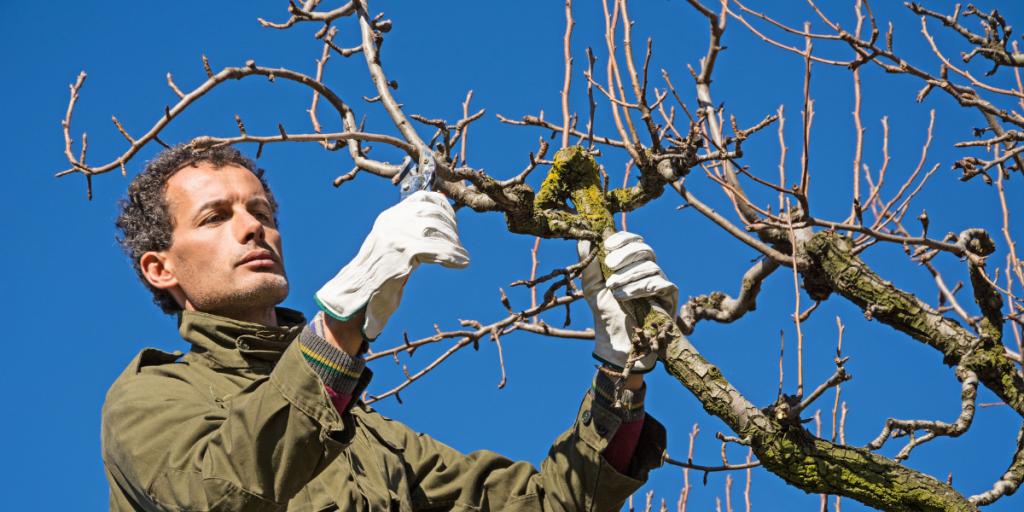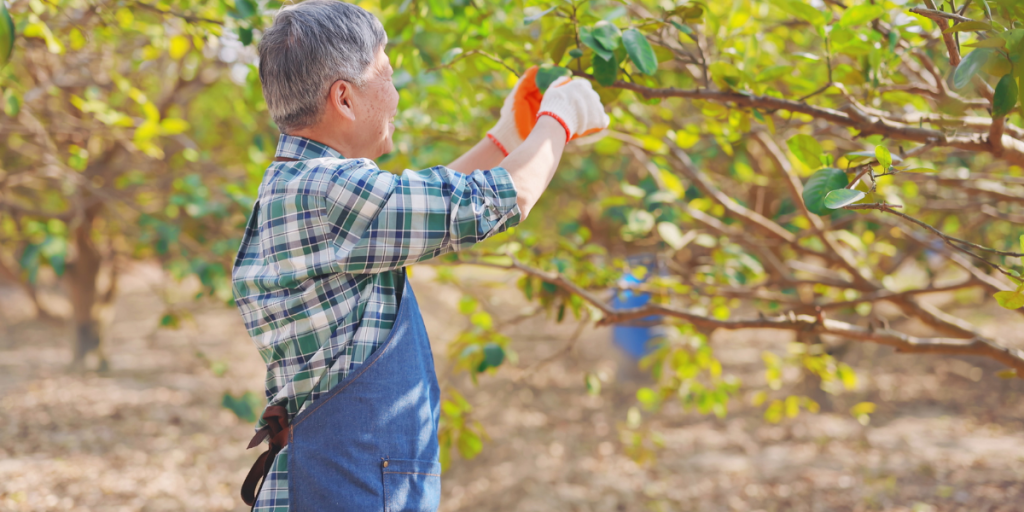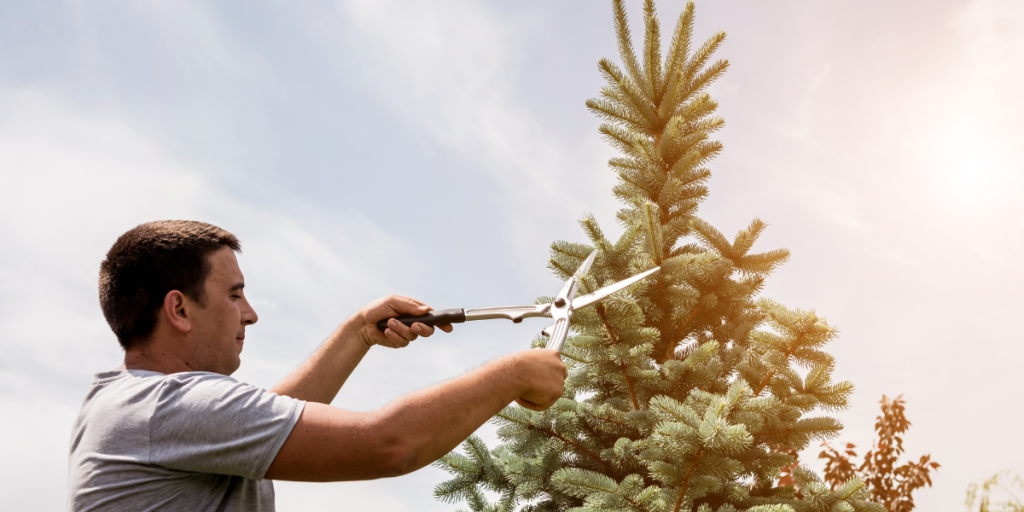Trim and Secure: Promoting Safety in Your Outdoor Spaces with Tree Pruning
Trees are an integral and valuable part of our outdoor spaces, providing numerous benefits to the environment, human health, and overall well-being. From towering forests to urban parks and residential gardens, trees enrich our surroundings and contribute to a sustainable ecosystem. However, while their presence is highly valued, it is essential to recognize the significance of responsible tree maintenance to ensure safety and maximize their positive impact. This article explores the importance of trees in outdoor spaces, safety considerations in tree maintenance, and the role of proper tree pruning in enhancing safety.
Understanding Tree Pruning
Tree pruning is a horticultural practice that involves selectively removing specific branches or parts of a tree to improve its health, shape, and overall appearance. Pruning is an essential aspect of tree care and is performed for various reasons, including safety, aesthetics, and promoting healthy growth. By removing dead, diseased, or structurally weak branches, the tree’s resources can be better directed to support the development of strong, healthy branches.
Pruning is not the same as tree trimming, which generally involves the removal of overgrown or unwanted foliage for aesthetics or clearance purposes. Pruning, on the other hand, is a more targeted approach and requires a deeper understanding of tree biology to ensure the tree’s long-term health and vitality.
Different Types of Tree Pruning Techniques:
- Crown Thinning: This method involves selectively removing inner branches and foliage from the crown of the tree. It helps to increase light penetration and air circulation throughout the canopy, reducing the risk of disease and promoting overall tree health.
- Crown Raising: Crown raising entails the removal of lower branches to create clearance underneath the tree. This technique is often used to prevent obstruction of walkways, roads, or buildings and to allow more space for pedestrian or vehicle traffic.
- Crown Reduction: Crown reduction involves pruning the outer edges of the tree’s canopy to reduce its overall size. This technique is used when a tree has grown too large for its surroundings, poses a safety risk, or interferes with utility lines.
- Deadwooding: Deadwooding is the removal of dead or dying branches from a tree. These lifeless branches can be hazardous as they are more prone to falling, and their presence can attract pests and diseases. Removing deadwood improves the safety and health of the tree.
- Structural Pruning: This type of pruning is typically performed on young trees to guide their growth and shape the tree’s structure as it develops. By selectively removing certain branches early on, the tree can be encouraged to grow with a strong and well-balanced framework.
The Benefits of Regular Tree Pruning:
- Improved Tree Health: By removing dead or diseased branches, the tree’s resources can be redirected to support the growth of healthy branches and foliage. Pruning can also enhance air circulation and sunlight exposure, reducing the risk of fungal infections and promoting overall tree vitality.
- Safety: Pruning helps eliminate hazardous branches that could potentially fall and cause injury or property damage during storms or high winds.
- Aesthetics: Proper pruning enhances the tree’s appearance, maintaining its natural shape, and ensuring it complements its surroundings.
- Increased Fruit Production: Fruit trees can benefit from pruning, as it stimulates new growth and improves fruit production by allowing more sunlight to reach the fruit-bearing branches.
- Structural Integrity: Early structural pruning of young trees helps create a well-balanced and sturdy framework, reducing the likelihood of weak branch attachments and potential tree failure as the tree matures.
- Disease Prevention: By removing diseased or infested branches promptly, the spread of diseases and pests can be minimized, safeguarding the tree’s overall health.
- Restoration: Pruning can be used to revitalize neglected or damaged trees, promoting new growth and rejuvenating their appearance.
Enhancing Safety through Proper Tree Pruning
Removing dead or diseased branches:
- Potential hazards of dead branches: Dead branches pose a significant risk to both property and human safety. They are prone to breaking off, especially during storms or strong winds, and can fall onto structures, vehicles, or people below. These falling branches can cause severe injuries, property damage, and even fatalities.
- How pruning prevents falling branch accidents: Pruning involves the selective removal of dead or diseased branches from trees. By regularly inspecting and removing such branches, arborists or property owners can eliminate the potential hazards. Pruning promotes the overall health of the tree and reduces the likelihood of weak or dead limbs, significantly lowering the risk of falling branch accidents.
Preventing overhanging branches:
- Dangers of overhanging branches: Overhanging branches can be a threat to property and pedestrians. During storms or strong winds, these branches may break off and damage structures like roofs, windows, and fences. Additionally, they can obstruct walkways and roads, creating a safety hazard for people passing underneath.
- Pruning to maintain safe clearance from structures and walkways: Proper tree pruning involves strategically cutting back overhanging branches to maintain a safe clearance from nearby structures, power lines, and pedestrian pathways. This reduces the risk of property damage and minimizes the chance of accidents caused by falling branches. Regular pruning helps to keep the tree’s growth in check, preventing branches from encroaching on areas where they might cause harm.
Reducing the risk of storm damage:
- Wind resistance and structural integrity: Pruning can enhance a tree’s wind resistance and structural integrity. By removing weak, crossing, or overly dense branches, the tree becomes more aerodynamic and less likely to suffer extensive damage during storms. Proper pruning encourages a well-balanced canopy, reducing the risk of large branches breaking off due to wind forces.
- How pruning can minimize storm-related hazards: During storms, trees with dense canopies or weak branches are more susceptible to wind damage. Pruning helps to thin out the tree’s foliage, allowing wind to pass through more easily, thereby reducing the risk of uprooting or breaking. This practice significantly mitigates the potential hazards posed by fallen trees and branches during severe weather events.
Addressing potential insect infestations:
- Identifying signs of infestation: Pruning is not only beneficial for physical hazards but can also address potential insect infestations. Signs of infestation include the presence of boreholes, sawdust-like frass around the tree’s trunk, wilting or discolored leaves, and the appearance of pests on the tree.
- Pruning to mitigate pest-related risks: When an infestation is identified, targeted pruning can be employed to remove affected branches or limbs. This action helps to contain the spread of pests within the tree and prevents them from infesting other healthy trees nearby. Moreover, removing infested branches can enhance the tree’s overall health and resilience, making it less susceptible to further pest attacks.
The Professional Approach to Tree Pruning
Importance of hiring a certified arborist
Tree pruning is a crucial aspect of tree care that requires expertise, precision, and knowledge of the various tree species and their growth patterns. Hiring a certified arborist is essential to ensure that the pruning process is carried out professionally and with the tree’s best interests in mind. Here’s why a certified arborist is invaluable:
- Expertise: Certified arborists have undergone extensive training and possess specialized knowledge in arboriculture. They understand the biology of trees, know the proper pruning techniques, and can identify signs of diseases or structural issues that may affect the tree’s health.
- Tree Health and Longevity: Improper pruning can harm the tree’s health, lead to structural problems, and even shorten its lifespan. Certified arborists know how to make precise cuts to promote healthy growth, improve the tree’s aesthetics, and prevent potential hazards.
- Safety: Tree pruning can be a hazardous task, especially when dealing with large trees or using climbing equipment. Certified arborists are trained in safety protocols and have the necessary experience to handle pruning projects safely, minimizing the risk of accidents or property damage.
- Insurance and Liability: Hiring a certified arborist provides an added layer of protection. In case of any unforeseen accidents or damages during the pruning process, reputable arborists carry liability insurance to cover potential losses.
- Compliance with Local Regulations: Some cities or municipalities may have specific regulations regarding tree pruning, especially for public trees. Certified arborists are well-versed in local ordinances and will ensure that the pruning work is done in compliance with these rules.
Safety precautions and equipment during pruning:
Tree pruning involves using various tools and equipment, and it should always be approached with safety as the top priority. Here are some essential safety precautions and equipment that certified arborists employ during the pruning process:
- Personal Protective Equipment (PPE): Arborists wear appropriate PPE, such as helmets, eye protection, ear protection, gloves, and chainsaw-resistant clothing to safeguard against potential hazards like falling debris, wood chips, or equipment malfunctions.
- Proper Equipment: Certified arborists use professional-grade tools and equipment designed for tree pruning, including pruning shears, handsaws, pole saws, chainsaws, and climbing gear like harnesses and ropes.
- Climbing Safety: When pruning trees at height, arborists use secure climbing techniques, such as double-rope systems, to prevent falls. Additionally, they inspect trees for stability and potential hazards before climbing.
- Pruning Techniques: Arborists are trained in various pruning techniques, such as crown thinning, crown raising, and crown reduction. They make cuts carefully to minimize damage to the tree and prevent the spread of diseases.
- Teamwork and Communication: For more extensive pruning projects, arborists often work in teams to enhance safety and efficiency. Good communication is essential to ensure everyone is aware of the tasks being performed and potential risks.
DIY Tree Pruning Tips for Homeowners
Pruning Tools and Equipment Needed:
Before embarking on any tree pruning project, it’s essential to gather the necessary tools and equipment. Here are some common pruning tools that homeowners may need:
- Hand Pruners: These are small, handheld shears designed for cutting branches up to ¾ inch in diameter. They are ideal for precision pruning and removing small, dead, or diseased branches.
- Loppers: Loppers have long handles and are suitable for cutting branches up to 2 inches in diameter. They provide more leverage than hand pruners, making them useful for thicker branches.
- Pruning Saw: A pruning saw is necessary for cutting larger branches. Choose a saw with a curved blade and sharp teeth for efficient cutting.
- Pole Pruner or Pruning Pole Saw: For branches that are out of reach, a pole pruner or pruning pole saw allows you to cut branches at higher elevations safely.
- Safety Equipment: When pruning trees, safety should be a top priority. Wear safety goggles, gloves, and a hard hat to protect yourself from falling debris.
- Disinfectant: To prevent the spread of diseases between trees, it’s important to clean and disinfect your pruning tools regularly.
Safety Measures Beyond Pruning
Monitoring tree health regularly
Regular monitoring of tree health is crucial for maintaining a safe outdoor environment. Trees can face various issues such as diseases, pest infestations, structural weaknesses, and environmental stressors. By conducting routine inspections, property owners, arborists, or trained professionals can identify early warning signs of potential problems and take appropriate actions to mitigate risks.
Here are some aspects of monitoring tree health regularly:
- Visual Inspections: Professionals or property owners should visually inspect trees for signs of decay, dead branches, cracks, or other structural weaknesses. Fungi growth, cankers, and abnormal leaf patterns may also indicate health issues.
- Soil and Root Analysis: The condition of the soil and tree roots significantly impacts tree health. Regular soil testing and root examinations help identify nutrient deficiencies, soil compaction, or root damage due to construction or other activities.
- Pest and Disease Management: Monitoring for pests and diseases is essential to catch infestations early. Prompt identification and treatment can prevent the spread of harmful pathogens and protect tree health.
- Pruning and Trimming: While pruning was mentioned as a safety measure beyond basic pruning, it also plays a role in monitoring tree health. Removing dead or diseased branches can prevent potential hazards and promote the overall well-being of the tree.
- Annual Checkups: Regularly scheduled annual checkups by professional arborists can ensure comprehensive assessments of tree health and identify any issues that might not be evident to the untrained eye.
Tree cabling and bracing for added support
Cabling and bracing are techniques used to provide additional support to trees with structural weaknesses, heavy limbs, or multiple trunks. These methods help reduce the risk of limb failure and tree splitting, especially during storms or adverse weather conditions. The installation of cables and braces is typically done by certified arborists to ensure proper techniques and equipment are used.
Here’s how tree cabling and bracing work:
- Cabling: Cabling involves the installation of high-strength steel cables between major limbs or multiple trunks. This helps to limit excessive movement and stress on weak or heavy branches, reducing the chances of them breaking or falling.
- Bracing: Bracing involves the installation of rigid rods or braces into the tree’s weak crotches or forked unions. This helps provide additional support and stabilizes weak attachment points, minimizing the risk of structural failure.
- Assessing Tree Structure: Before cabling and bracing, a thorough assessment of the tree’s structure is necessary to determine the appropriate locations for support systems. Arborists will identify potential hazards and weak points that require reinforcement.
- Regular Maintenance: Cables and braces need periodic inspections and adjustments to ensure they remain effective. As the tree grows, the support system may need to be modified to accommodate its changing structure.
Fostering a safe outdoor environment
Creating a safe outdoor environment goes beyond just tree-specific measures and encompasses various aspects of landscape management and safety protocols. Here are some considerations to foster a safe outdoor environment:
- Pathways and Lighting: Ensure well-maintained pathways and proper lighting throughout the outdoor area to prevent trip hazards and improve visibility during the night.
- Hazardous Materials: Keep hazardous materials like chemicals, fertilizers, and sharp tools securely stored and away from children or unauthorized individuals.
- Regular Inspections: Conduct regular inspections of outdoor structures, such as playsets, benches, and fences, to identify any signs of wear, damage, or potential hazards.
- Water Management: Properly manage water drainage and irrigation to avoid soil erosion and potential water-related hazards.
- Tree Placement: When landscaping, consider the mature size of trees and their distance from structures, power lines, and other trees to prevent potential conflicts or hazards as they grow.
- Educating Residents: Educate residents, especially children, about outdoor safety, including the importance of not climbing trees near power lines and using outdoor equipment properly.
- Emergency Preparedness: Have an emergency plan in place in case of severe weather events or other outdoor emergencies.
Frequently Asked Questions
Why is tree pruning important for safety in outdoor spaces?
Proper tree pruning is crucial for safety in outdoor spaces because it helps eliminate potential hazards. Overgrown or damaged branches can pose risks of falling, especially during storms or high winds. Pruning ensures that the tree’s structure remains stable and reduces the likelihood of accidents or property damage caused by falling branches.
When is the best time to prune trees for safety purposes?
The best time to prune trees for safety is during their dormant season, typically in late fall or winter. Pruning during this period minimizes stress on the tree and reduces the risk of disease or insect infestations. However, if there are immediate safety concerns, dead or hazardous branches should be removed regardless of the season.
Can I prune my trees myself, or should I hire a professional for safety pruning?
While minor pruning of small branches may be done by homeowners, safety pruning should be left to certified arborists or tree care professionals. They have the expertise to identify potential hazards and use proper pruning techniques to enhance safety without causing damage to the tree.
How does pruning prevent tree-related accidents during storms?
Pruning helps reduce the wind resistance of trees by removing dead or weak branches. When storms strike, trees with proper pruning are less likely to have limbs or branches break off and cause damage to property or endanger people nearby.
Can pruning save a tree that is showing signs of decline or disease?
In some cases, yes. Pruning can remove diseased or dead branches, improving the overall health of the tree and giving it a better chance of recovery. However, if the tree is severely compromised or has advanced decay, removal might be the safest option to prevent accidents.
Conclusion
In conclusion, the significance of proper tree pruning cannot be overstated. It is not only an art form that enhances the aesthetic appeal of trees but also a science-based practice that fosters their well-being and ensures the safety of the spaces they inhabit. Let us embrace a culture of responsible tree care, valuing the role trees play in our ecosystem and taking the necessary steps to protect and nurture them for future generations. Through mindful and informed tree pruning practices, we can create a sustainable and beautiful outdoor environment that benefits us all.
from AAA Tree Lopping Ipswich https://ift.tt/Paz0Rn5
via IFTTT





